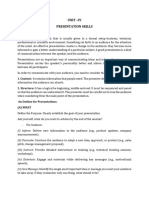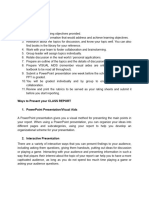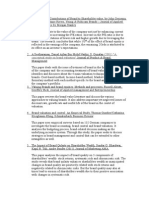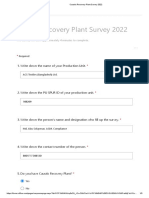Guidelines On Reporting
Uploaded by
trixiemariezamoraGuidelines On Reporting
Uploaded by
trixiemariezamoraGUIDELINES FOR REPORTING
When reporting on different types of written formats such as research-based argumentative essays,
explanatory essays, blogs, business letters, memorandums, and minutes of meetings, it is essential
to understand their unique structures and purposes. Below are guidelines for each format to help
you prepare effective reports.
1. Research-Based Argumentative Essay
Purpose: To argue a specific position based on research and evidence.
Structure:
• Introduction: Present the topic, provide background information, and state your thesis.
• Literature Review: Summarize existing research relevant to your argument.
• Body Paragraphs:
• Present arguments supported by evidence.
• Include counterarguments and refute them.
• Conclusion: Summarize key points and restate the thesis in light of the evidence.
Key Elements:
• Use credible sources and cite them properly.
• Maintain a logical flow of ideas.
• Use persuasive language to strengthen your argument.
2. Explanatory Essay
Purpose: To explain a topic or concept clearly and objectively.
Structure:
• Introduction: Introduce the topic and its significance; include a thesis statement.
• Body Paragraphs:
• Break down the topic into key points or aspects.
• Use examples and explanations to clarify each point.
• Conclusion: Recap the main points and emphasize the importance of understanding the topic.
Key Elements:
• Focus on clarity and objectivity.
• Use clear transitions between paragraphs.
• Avoid personal opinions; stick to factual information.
3. Blogs
Purpose: To engage readers with informative or entertaining content in a conversational
tone.Structure:
• Title: Catchy and relevant to attract readers.
• Introduction: Hook the reader with an interesting opening; introduce the main topic.
• Body:
• Use subheadings for organization.
• Include personal anecdotes, examples, or visuals to enhance engagement.
• Conclusion: Summarize key takeaways or include a call to action.
Key Elements:
• Write in an informal, relatable style.
• Use visuals (images, videos) to break up text and add interest.
• Encourage reader interaction through comments or social media sharing.
4. Business Letters
Purpose: To communicate formally in a professional context.
Structure:
• Sender’s Address: Your address at the top right (optional).
• Date: Include the date below your address.
• Recipient’s Address: The recipient’s name and address on the left side.
• Salutation: Use a formal greeting (e.g., "Dear Mr./Ms. [Last Name]").
• Body Paragraphs:
• Introduction: State the purpose of the letter.
• Main Content: Provide details clearly and concisely.
• Conclusion: Summarize your request or action needed.
• Closing Signature: Use a formal closing (e.g., "Sincerely") followed by your name.
Key Elements:
• Maintain a professional tone throughout.
• Be clear and concise; avoid unnecessary jargon.
• Proofread for grammatical accuracy and clarity.
Note: Discuss different types of business letters
5. Memorandum
Purpose: To communicate important information within an organization.
Structure:
• Header: Include "To," "From," "Date," "Subject."
• Introduction/Opening Statement: Clearly state the purpose of the memo.
• Body Paragraphs:
• Provide detailed information or instructions related to the subject matter.
• Use bullet points or numbered lists for clarity if necessary.
• Conclusion/Call to Action: Summarize any actions required from the recipients.
Key Elements:
• Keep it brief; focus on essential information only.
• Use clear headings or subheadings if necessary for organization.
• Maintain a professional tone.
6. Minutes of the Meeting
Purpose: To document discussions, decisions, and action items from a meeting.
Structure:
• Header Information: Include date, time, location, attendees, and absentees.
• Call to Order/Opening Remarks: Briefly note who called the meeting to order and any opening
statements made.
• Body Sections by Agenda Item:
• Record discussions under each agenda item in order.
• Note decisions made and assigned action items with deadlines if applicable.
• Conclusion/Adjournment: State when the meeting was adjourned.
Key Elements:
• Be objective; report what was said without personal opinions or interpretations.
• Use clear headings for each agenda item for easy reference.
• Distribute minutes promptly after the meeting for accuracy.
Needs Improve
Criteria Excellent (10-9 points) Good (8-7 points) Fair (6-5 points) ment (4-1 points) Score
Covers the topic
Thoroughly covers the topic adequately with mostly Covers some aspects of Fails to cover the topic
with accurate and relevant accurate information; the topic but lacks adequately; significant
information; demonstrates shows good depth; some inaccuracies or
Content deep understanding. understanding. inaccuracies present. irrelevant information.
Information is mostly Some organization Disorganized
Information is presented in organized; minor issues present, but difficult to presentation; hard to
a clear, logical order; easy with flow or clarity are follow at times; lacks follow and understand
Organization to follow throughout. present. clear transitions. the main points.
Confident and engaging Good delivery; Poor delivery; little to
delivery; maintains eye maintains eye contact Delivery is hesitant or no eye contact,
contact and uses most of the time and lacks engagement; distracting
appropriate gestures uses some gestures limited eye contact and mannerisms, or
Delivery effectively. effectively. few gestures used. monotone voice.
Visual aids are highly Visual aids are relevant Visual aids are present
effective, relevant, and and support the but poorly designed or No visual aids used, or
significantly enhance presentation but could not effectively those that were used
understanding of the be improved in clarity or integrated into the were irrelevant or
Visual Aids content. design. presentation. distracting.
Engages the audience at Does not engage the
Actively engages the times but lacks Limited audience audience; no
audience with questions or consistent interaction or engagement; few interaction or
discussions; encourages encouragement for opportunities for participation
Engagement participation throughout. participation. interaction provided. encouraged at all.
Completes presentation Presentation exceeds Presentation is poorly
Completes presentation within time limits but time limits or is timed, either too short
within the allotted time may rush through some significantly under or excessively long
Time while covering all points points or omit minor time; important points without covering key
Management thoroughly and effectively. details. omitted. points effectively.
Reporting guidelines:
Duration of Presentation
Time Limit: The presentation must be between 20 to 25 minutes in length.
Preparation: Practice your presentation multiple times to ensure you can deliver your content within
this time frame.
Pacing: Aim for approximately 1 to 1.5 minutes per slide if using PowerPoint, allowing time for
explanations and audience interaction.
2. PowerPoint Slides
Maximum Number of Slides: Your PowerPoint presentation should contain no more than 15 slides.
Structure of the Presentation
Introduction (2-3 minutes):
Introduce yourself and the topic.
State the purpose of your presentation and what you aim to achieve.
Body (15-20 minutes):
Divide the body into clear sections based on your main points.
Each section should have its own slide(s) that correspond to the content being discussed.
Use transitions between slides to maintain flow.
Conclusion (2-3 minutes):
Summarize the key points made during the presentation.
Reinforce the significance of the topic and any conclusions drawn.
You might also like
- POWERPOINT PRESENTATION FOR BUSINESS COMMUNICATIONNo ratings yetPOWERPOINT PRESENTATION FOR BUSINESS COMMUNICATION2 pages
- report_on_giving_effective_presentation[1]No ratings yetreport_on_giving_effective_presentation[1]6 pages
- Seven Preparatory Steps of Presentation Final TermNo ratings yetSeven Preparatory Steps of Presentation Final Term15 pages
- What Is Rubric and Types of Rubrics Assessment 2No ratings yetWhat Is Rubric and Types of Rubrics Assessment 212 pages
- How to Prepare and Deliver a PresentationNo ratings yetHow to Prepare and Deliver a Presentation15 pages
- How To Make Powerpoint Presentations EffectivelyNo ratings yetHow To Make Powerpoint Presentations Effectively4 pages
- EPD397 Elevator Talk Self Evaluation - LaneNo ratings yetEPD397 Elevator Talk Self Evaluation - Lane1 page
- Reporting-Guidelines-Rubrics-References-and-Topic-AssignmentNo ratings yetReporting-Guidelines-Rubrics-References-and-Topic-Assignment3 pages
- The Process For Developing and Delivering A PresentationNo ratings yetThe Process For Developing and Delivering A Presentation5 pages
- Ai Rosidah, S.Pd. - NK 12 Kantung Tugas 3aNo ratings yetAi Rosidah, S.Pd. - NK 12 Kantung Tugas 3a5 pages
- CLASS REPORTING Guidelines and Rubrics 1No ratings yetCLASS REPORTING Guidelines and Rubrics 15 pages
- Soft Skills Element Universiti Tun Hussien Onn Malaysia: Lampiran 2No ratings yetSoft Skills Element Universiti Tun Hussien Onn Malaysia: Lampiran 27 pages
- Lecture-10= Understanding Active ListeningNo ratings yetLecture-10= Understanding Active Listening24 pages
- Life Management _Class Reporting Instructions and RubricNo ratings yetLife Management _Class Reporting Instructions and Rubric2 pages
- Oral Presentation Rubric and Evaluation Form PDFNo ratings yetOral Presentation Rubric and Evaluation Form PDF3 pages
- (2001) "A Conceptual Study On Brand Valuation"No ratings yet(2001) "A Conceptual Study On Brand Valuation"3 pages
- Prevention of Illegal Working and Right To Work in The UK PolicyNo ratings yetPrevention of Illegal Working and Right To Work in The UK Policy7 pages
- Caustic Recovery Plant Survey 2022-ACS TextilesNo ratings yetCaustic Recovery Plant Survey 2022-ACS Textiles3 pages
- School Education Department - Allocation of Employees - Warangal DistrictNo ratings yetSchool Education Department - Allocation of Employees - Warangal District17 pages
- Critical Areas in Region 4A, PhilippinesNo ratings yetCritical Areas in Region 4A, Philippines3 pages
- Beyond the Mountain 1st Edition B. Camminga - The ebook in PDF and DOCX formats is ready for download now100% (2)Beyond the Mountain 1st Edition B. Camminga - The ebook in PDF and DOCX formats is ready for download now47 pages
- Instructions: End Semester Examination 2021 English For Communication (HSIR 11) Time-2 HourNo ratings yetInstructions: End Semester Examination 2021 English For Communication (HSIR 11) Time-2 Hour3 pages
- Alaska Pollock Fishery Alliance Press ReleaseNo ratings yetAlaska Pollock Fishery Alliance Press Release1 page
- Official ISC 2 Guide to the CSSLP CBK 2nd Edition Mano Paul 2024 Scribd Download100% (1)Official ISC 2 Guide to the CSSLP CBK 2nd Edition Mano Paul 2024 Scribd Download51 pages
- Budget Motivation Speech For Prison ServicesNo ratings yetBudget Motivation Speech For Prison Services9 pages
- International Relations and Diplomacy ISNo ratings yetInternational Relations and Diplomacy IS66 pages
- CAPM Proof That Market Portfolio Is Value WeightedNo ratings yetCAPM Proof That Market Portfolio Is Value Weighted3 pages
- POWERPOINT PRESENTATION FOR BUSINESS COMMUNICATIONPOWERPOINT PRESENTATION FOR BUSINESS COMMUNICATION
- Seven Preparatory Steps of Presentation Final TermSeven Preparatory Steps of Presentation Final Term
- Reporting-Guidelines-Rubrics-References-and-Topic-AssignmentReporting-Guidelines-Rubrics-References-and-Topic-Assignment
- The Process For Developing and Delivering A PresentationThe Process For Developing and Delivering A Presentation
- Soft Skills Element Universiti Tun Hussien Onn Malaysia: Lampiran 2Soft Skills Element Universiti Tun Hussien Onn Malaysia: Lampiran 2
- Life Management _Class Reporting Instructions and RubricLife Management _Class Reporting Instructions and Rubric
- Prevention of Illegal Working and Right To Work in The UK PolicyPrevention of Illegal Working and Right To Work in The UK Policy
- School Education Department - Allocation of Employees - Warangal DistrictSchool Education Department - Allocation of Employees - Warangal District
- Beyond the Mountain 1st Edition B. Camminga - The ebook in PDF and DOCX formats is ready for download nowBeyond the Mountain 1st Edition B. Camminga - The ebook in PDF and DOCX formats is ready for download now
- Instructions: End Semester Examination 2021 English For Communication (HSIR 11) Time-2 HourInstructions: End Semester Examination 2021 English For Communication (HSIR 11) Time-2 Hour
- Official ISC 2 Guide to the CSSLP CBK 2nd Edition Mano Paul 2024 Scribd DownloadOfficial ISC 2 Guide to the CSSLP CBK 2nd Edition Mano Paul 2024 Scribd Download
- CAPM Proof That Market Portfolio Is Value WeightedCAPM Proof That Market Portfolio Is Value Weighted

























































































